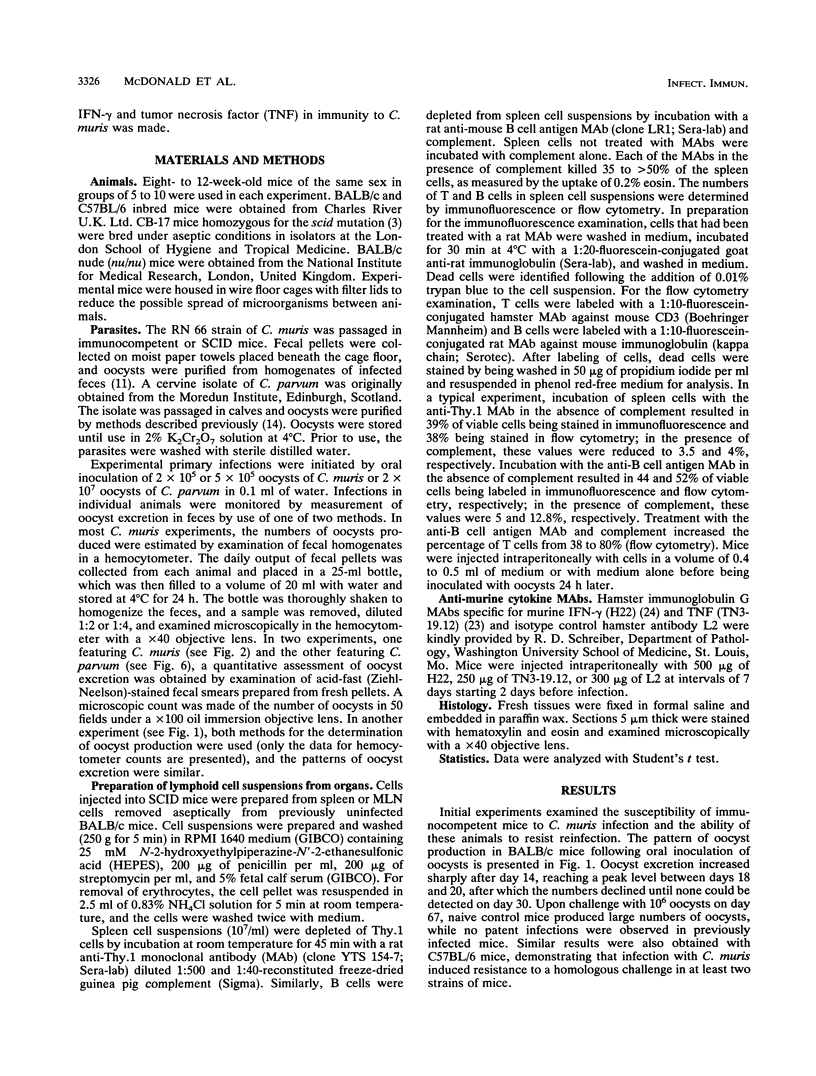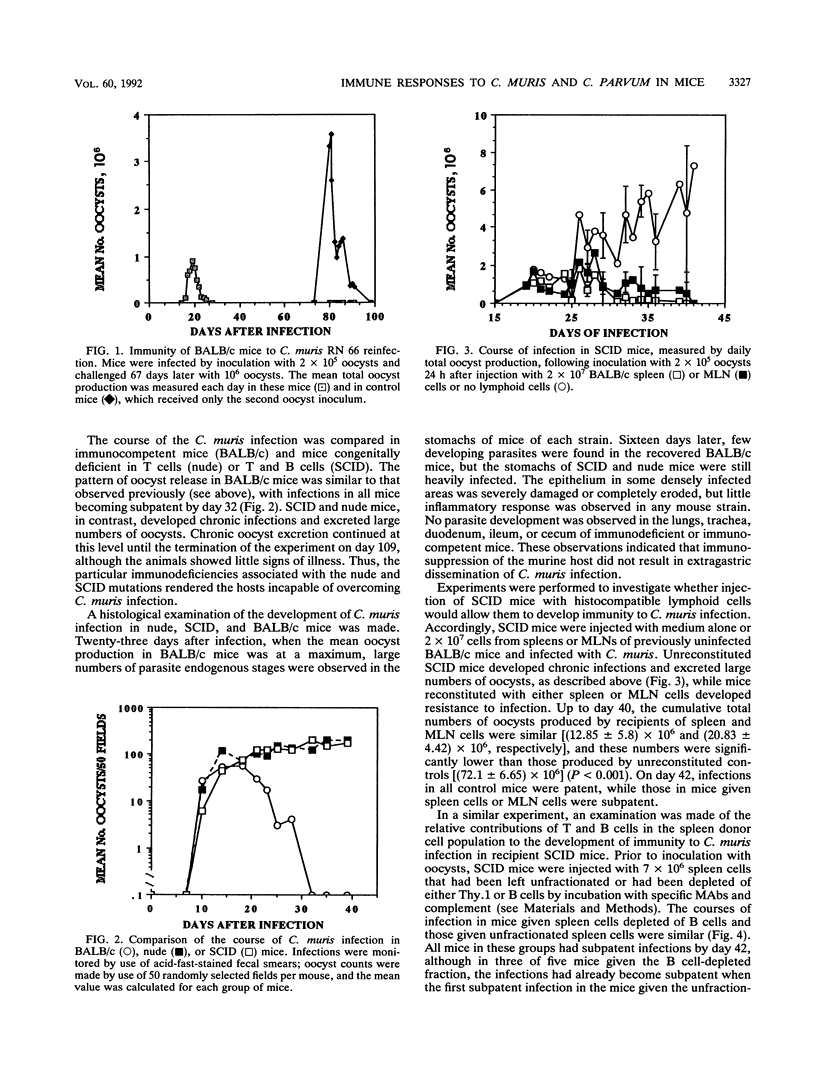Abstract
Adult murine models of Cryptosporidium infection involving Cryptosporidium muris and C. parvum were used to study immunity to cryptosporidiosis in the mammalian host. Immunocompetent BALB/c or C57BL/6 mice developed a highly patent infection with the RN 66 strain of C. muris but overcame the infection and were immune to reinfection. In contrast, severe combined immunodeficiency (SCID) mice or nude mice had a chronic infection lasting at least 109 days. The development of the C. muris infection appeared to be confined to the gastric epithelium in immunocompetent and immunocompromised mice. SCID mice injected intraperitoneally with histocompatible spleen or mesenteric lymph node cells from uninfected BALB/c mice were able to recover from the C. muris infection. The protective effect of donor spleen cells was not reduced by depletion of the B cell population but was significantly reduced by depletion of Thy.1 cells. Treatment of C57BL/6 or BALB/c mice during infection with a gamma interferon-neutralizing monoclonal antibody, but not a tumor necrosis factor-neutralizing monoclonal antibody, resulted in a significant increase in oocyst production. In the C. parvum model, a severe and eventually fatal chronic infection with a cervine isolate was established in SCID mice, with parasitization occurring in the ileum, cecum, and colon. SCID mice injected with unprimed BALB/c spleen cells prior to inoculation of C. parvum oocysts were resistant to infection. These results suggested that the two animal models should be valuable in the study of immunity to cryptosporidial infection.
Full text
PDF






Selected References
These references are in PubMed. This may not be the complete list of references from this article.
- Bird R. G., Smith M. D. Cryptosporidiosis in man: parasite life cycle and fine structural pathology. J Pathol. 1980 Nov;132(3):217–233. doi: 10.1002/path.1711320304. [DOI] [PubMed] [Google Scholar]
- Bosma G. C., Custer R. P., Bosma M. J. A severe combined immunodeficiency mutation in the mouse. Nature. 1983 Feb 10;301(5900):527–530. doi: 10.1038/301527a0. [DOI] [PubMed] [Google Scholar]
- Brasseur P., Lemeteil D., Ballet J. J. Rat model for human cryptosporidiosis. J Clin Microbiol. 1988 May;26(5):1037–1039. doi: 10.1128/jcm.26.5.1037-1039.1988. [DOI] [PMC free article] [PubMed] [Google Scholar]
- Fayer R., Andrews C., Ungar B. L., Blagburn B. Efficacy of hyperimmune bovine colostrum for prophylaxis of cryptosporidiosis in neonatal calves. J Parasitol. 1989 Jun;75(3):393–397. [PubMed] [Google Scholar]
- Fayer R., Ungar B. L. Cryptosporidium spp. and cryptosporidiosis. Microbiol Rev. 1986 Dec;50(4):458–483. doi: 10.1128/mr.50.4.458-483.1986. [DOI] [PMC free article] [PubMed] [Google Scholar]
- Gardner A. L., Roche J. K., Weikel C. S., Guerrant R. L. Intestinal cryptosporidiosis: pathophysiologic alterations and specific cellular and humoral immune responses in rnu/+ and rnu/rnu (athymic) rats. Am J Trop Med Hyg. 1991 Jan;44(1):49–62. doi: 10.4269/ajtmh.1991.44.49. [DOI] [PubMed] [Google Scholar]
- Heine J., Moon H. W., Woodmansee D. B. Persistent Cryptosporidium infection in congenitally athymic (nude) mice. Infect Immun. 1984 Mar;43(3):856–859. doi: 10.1128/iai.43.3.856-859.1984. [DOI] [PMC free article] [PubMed] [Google Scholar]
- Iseki M., Maekawa T., Moriya K., Uni S., Takada S. Infectivity of Cryptosporidium muris (strain RN 66) in various laboratory animals. Parasitol Res. 1989;75(3):218–222. doi: 10.1007/BF00931279. [DOI] [PubMed] [Google Scholar]
- Kogut M. H., Lange C. Interferon-gamma-mediated inhibition of the development of Eimeria tenella in cultured cells. J Parasitol. 1989 Apr;75(2):313–317. [PubMed] [Google Scholar]
- Louie E., Borkowsky W., Klesius P. H., Haynes T. B., Gordon S., Bonk S., Lawrence H. S. Treatment of cryptosporidiosis with oral bovine transfer factor. Clin Immunol Immunopathol. 1987 Sep;44(3):329–334. doi: 10.1016/0090-1229(87)90077-8. [DOI] [PubMed] [Google Scholar]
- McDonald V., Deer R. M., Nina J. M., Wright S., Chiodini P. L., McAdam K. P. Characteristics and specificity of hybridoma antibodies against oocyst antigens of Cryptosporidium parvum from man. Parasite Immunol. 1991 May;13(3):251–259. doi: 10.1111/j.1365-3024.1991.tb00280.x. [DOI] [PubMed] [Google Scholar]
- Mead J. R., Arrowood M. J., Sidwell R. W., Healey M. C. Chronic Cryptosporidium parvum infections in congenitally immunodeficient SCID and nude mice. J Infect Dis. 1991 Jun;163(6):1297–1304. doi: 10.1093/infdis/163.6.1297. [DOI] [PubMed] [Google Scholar]
- Moon H. W., Woodmansee D. B., Harp J. A., Abel S., Ungar B. L. Lacteal immunity to enteric cryptosporidiosis in mice: immune dams do not protect their suckling pups. Infect Immun. 1988 Mar;56(3):649–653. doi: 10.1128/iai.56.3.649-653.1988. [DOI] [PMC free article] [PubMed] [Google Scholar]
- Pfefferkorn E. R. Interferon gamma blocks the growth of Toxoplasma gondii in human fibroblasts by inducing the host cells to degrade tryptophan. Proc Natl Acad Sci U S A. 1984 Feb;81(3):908–912. doi: 10.1073/pnas.81.3.908. [DOI] [PMC free article] [PubMed] [Google Scholar]
- Rehg J. E., Hancock M. L., Woodmansee D. B. Characterization of cyclophosphamide-rat model of cryptosporidiosis. Infect Immun. 1987 Nov;55(11):2669–2674. doi: 10.1128/iai.55.11.2669-2674.1987. [DOI] [PMC free article] [PubMed] [Google Scholar]
- Rose M. E., Wakelin D., Hesketh P. Interferon-gamma-mediated effects upon immunity to coccidial infections in the mouse. Parasite Immunol. 1991 Jan;13(1):63–74. doi: 10.1111/j.1365-3024.1991.tb00263.x. [DOI] [PubMed] [Google Scholar]
- Saxon A., Weinstein W. Oral administration of bovine colostrum anti-cryptosporidia antibody fails to alter the course of human cryptosporidiosis. J Parasitol. 1987 Apr;73(2):413–415. [PubMed] [Google Scholar]
- Schofield L., Ferreira A., Altszuler R., Nussenzweig V., Nussenzweig R. S. Interferon-gamma inhibits the intrahepatocytic development of malaria parasites in vitro. J Immunol. 1987 Sep 15;139(6):2020–2025. [PubMed] [Google Scholar]
- Schreiber R. D., Hicks L. J., Celada A., Buchmeier N. A., Gray P. W. Monoclonal antibodies to murine gamma-interferon which differentially modulate macrophage activation and antiviral activity. J Immunol. 1985 Mar;134(3):1609–1618. [PubMed] [Google Scholar]
- Sheehan K. C., Ruddle N. H., Schreiber R. D. Generation and characterization of hamster monoclonal antibodies that neutralize murine tumor necrosis factors. J Immunol. 1989 Jun 1;142(11):3884–3893. [PubMed] [Google Scholar]
- Shultz L. D., Sidman C. L. Genetically determined murine models of immunodeficiency. Annu Rev Immunol. 1987;5:367–403. doi: 10.1146/annurev.iy.05.040187.002055. [DOI] [PubMed] [Google Scholar]
- Suzuki Y., Conley F. K., Remington J. S. Treatment of toxoplasmic encephalitis in mice with recombinant gamma interferon. Infect Immun. 1990 Sep;58(9):3050–3055. doi: 10.1128/iai.58.9.3050-3055.1990. [DOI] [PMC free article] [PubMed] [Google Scholar]
- Taghi-Kilani R., Sekla L., Hayglass K. T. The role of humoral immunity in Cryptosporidium spp. infection. Studies with B cell-depleted mice. J Immunol. 1990 Sep 1;145(5):1571–1576. [PubMed] [Google Scholar]
- Tzipori S. Cryptosporidiosis in perspective. Adv Parasitol. 1988;27:63–129. doi: 10.1016/S0065-308X(08)60353-X. [DOI] [PMC free article] [PubMed] [Google Scholar]
- Tzipori S., Roberton D., Cooper D. A., White L. Chronic cryptosporidial diarrhoea and hyperimmune cow colostrum. Lancet. 1987 Aug 8;2(8554):344–345. doi: 10.1016/s0140-6736(87)90944-5. [DOI] [PubMed] [Google Scholar]
- Ungar B. L., Burris J. A., Quinn C. A., Finkelman F. D. New mouse models for chronic Cryptosporidium infection in immunodeficient hosts. Infect Immun. 1990 Apr;58(4):961–969. doi: 10.1128/iai.58.4.961-969.1990. [DOI] [PMC free article] [PubMed] [Google Scholar]
- Ungar B. L., Kao T. C., Burris J. A., Finkelman F. D. Cryptosporidium infection in an adult mouse model. Independent roles for IFN-gamma and CD4+ T lymphocytes in protective immunity. J Immunol. 1991 Aug 1;147(3):1014–1022. [PubMed] [Google Scholar]
- Ungar B. L., Ward D. J., Fayer R., Quinn C. A. Cessation of Cryptosporidium-associated diarrhea in an acquired immunodeficiency syndrome patient after treatment with hyperimmune bovine colostrum. Gastroenterology. 1990 Feb;98(2):486–489. doi: 10.1016/0016-5085(90)90842-o. [DOI] [PubMed] [Google Scholar]
- Uni S., Iseki M., Maekawa T., Moriya K., Takada S. Ultrastructure of Cryptosporidium muris (strain RN 66) parasitizing the murine stomach. Parasitol Res. 1987;74(2):123–132. doi: 10.1007/BF00536023. [DOI] [PubMed] [Google Scholar]
- Williams R. O., Burden D. J. Measurement of class specific antibody against cryptosporidium in serum and faeces from experimentally infected calves. Res Vet Sci. 1987 Sep;43(2):264–265. [PubMed] [Google Scholar]


